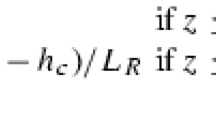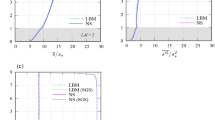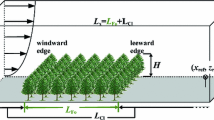Abstract
The two-scalar covariance budget is significant within the canopy sublayer (CSL) given its role in modelling scalar flux budgets using higher-order closure principles and in estimating the segregation ratio for chemically reactive species. Despite its importance, an explicit expression describing how the two-scalar covariance is modified by inhomogeneity in the flow statistics and in the vertical variation in scalar emission or uptake rates within the canopy volume remains elusive even for passive scalars. To progress on a narrower version of this problem, an analytical solution to the two-scalar covariance budget in the CSL is proposed for the most idealized flow conditions: a stationary and planar homogeneous flow inside a uniform and dense canopy with a constant leaf area density distribution. The foliage emission (or uptake) source strengths are assumed to vary exponentially with depth while the forest floor emission is represented as a scalar flux. The analytical solution is a superposition of a homogeneous part that describes how the two-scalar covariance at the canopy top is transported and dissipated within the canopy volume, and an inhomogeneous part governed by local production mechanisms of the two-scalar covariance. The homogeneous part is primarily described by the canopy adjustment length scale, and the attenuation coefficients of the turbulent kinetic energy and the mean velocity. Conditions for which the vertical variation of the two-scalar covariance is controlled by the rapid attenuation in the mean velocity and turbulent kinetic energy profiles, vis-à-vis the vertical variation of the scalar source strength, are explicitly established. This model also demonstrates how dissimilarity in the emissions from the ground, even for the extreme binary case with one scalar turned ‘on’ and the other scalar turned ‘off’, modifies the vertical variation of the two-scalar covariance within the CSL. To assess its applicability to field conditions, the analytical model predictions were compared with observations made at two different forest types—a sparse pine forest at the Hyytiälä SMEAR II-station (in Finland) and a dense alpine hardwood forest at Lavarone (in Italy). While the model assumptions do not represent the precise canopy morphology, attenuation properties of the turbulent kinetic energy and the mean velocity, observed mixing length, and scalar source attenuation properties for these two forest types, good agreement was found between measured and modelled two scalar covariances for multiple scalars and for the triple moments at the Hyytiälä site.
Similar content being viewed by others
References
Asanuma J, Tamagawa I, Ishikawa H, Ma YM, Hayashi T, Qi YQ, Wang J (2007) Spectral similarity between scalars at very low frequencies in the unstable atmospheric surface layer over the Tibetan plateau. Boundary-Layer Meteorol 122(1): 85–103. doi:10.1007/s10546-006-9096-y
Cava D, Katul GG (2008) Spectral short-circuiting and wake production within the canopy trunk space of an alpine hardwood forest. Boundary-Layer Meteorol 126(3): 415–431. doi:10.1007/s10546-007-9246-x
Cava D, Katul GG, Scrimieri A, Poggi D, Cescatti A, Giostra U (2006) Buoyancy and the sensible heat flux budget within dense canopies. Boundary-Layer Meteorol 118(1): 217–240. doi:10.1007/s10546-005-4736-1
Cava D, Katul GG, Sempreviva AM, Giostra U, Scrimieri A (2008) On the anomalous behavior of scalar flux-variance similarity functions within the canopy sub-layer of a dense Alpine forest. Boundary-Layer Meteorol 128: 33–57. doi:10.1007/s10546-008-9276-z
Cionco RM (1965) A mathematical model for air flow in a vegetative canopy. J Appl Meteorol 4: 517–522. doi:10.1175/1520-0450(1965)004<0517:AMMFAF>2.0.CO;2
Coulman CE (1980) Correlation between velocity, temperature and humidity fluctuations in the air above land and ocean. Boundary-Layer Meteorol 19: 403–420. doi:10.1007/BF00122342
Detto M, Katul GG (2007) Simplified expressions for adjusting higher-order turbulent statistics obtained from open path gas analyzers. Boundary-Layer Meteorol 122(1): 205–216. doi:10.1007/s10546-006-9105-1
Finnigan JJ, Belcher SE (2004) Flow over a hill covered with a plant canopy. Q J Roy Meteorol Soc 130: 1–29. doi:10.1256/qj.02.177
Friehe C, LaRue J, Champagne F, Gibson C, Dreyer GF (1975) Effects of temperature and humidity fluctuations on the optical refractive index in the marine boundary layer. J Opt Soc Am 65: 1502–1511. doi:10.1364/JOSA.65.001502
Gao W, Wesely ML (1994) Numerical modeling of the turbulent fluxes of chemically reactive trace gases in the atmospheric boundary-layer. J Appl Meteorol 33: 835–847. doi:10.1175/1520-0450(1994)033<0835:NMOTTF>2.0.CO;2
Gao W, Wesely ML, Doskey PV (1993) Numerical modeling of the turbulent-diffusion and chemistry of NOx, O3, Isoprene, and other reactive trace gases in and above a forest canopy. J Geophys Res Atmos 98: 18339–18353
Garratt JR (1992) The atmospheric boundary layer. Cambridge University Press, Cambridge, 316 pp
Inoue E (1963) On the turbulent structure of airflow within crop canopies. J Meteorol Soc Jpn 41: 317–326
Juang JY, Katul GG, Siqueira MB, Stoy PC, Palmroth S, McCarthy HR, Kim HS, Oren R (2006) Modeling nighttime ecosystem respiration from measured CO2 concentration and air temperature profiles using inverse methods. J Geophys Res Atmos 111(D8): D08s05
Juang JY, Katul GG, Siqueira MB, Stoy PC, McCarthy HR (2008) Investigating a hierarchy of Eulerian closure models for scalar transfer inside forested canopies. Boundary-Layer Meteorol 128: 1–32. doi:10.1007/s10546-008-9273-2
Katul GG, Mahrt L, Poggi D, Sanz C (2004) One and two equation models for canopy turbulence. Boundary-Layer Meteorol 113: 81–109. doi:10.1023/B:BOUN.0000037333.48760.e5
Katul GG, Finnigan JJ, Poggi D, Leuning R, Belcher S (2006) The influence of hilly terrain on canopy-atmosphere carbon dioxide exchange. Boundary-Layer Meteorol 118: 189–216. doi:10.1007/s10546-005-6436-2
Katul GG, Sempreviva AM, Cava D (2008) The temperature-humidity covariance in the marine surface layer: a one-dimensional analytical model. Boundary-Layer Meteorol 126: 263–278. doi:10.1007/s10546-007-9236-z
Lamaud E, Irvine M (2006) Temperature-humidity dissimilarity and heat-to-water-vapor transport efficiency above and within a pine forest canopy: the role of the Bowen ratio. Boundary-Layer Meteorol 120(1): 87–109. doi:10.1007/s10546-005-9032-6
Launiainen S, Vesala T, Mölder M, Mammarella I, Smolander S, Rannik Ü et al (2007) Vertical variability and effect of stability on turbulence characteristics down to the floor of a pine forest. Tellus 59: 919–936. doi:10.1111/j.1600-0889.2007.00313.x
Massman WJ (1997) An analytical one-dimensional model of momentum transfer by vegetation of arbitrary structure. Boundary-Layer Meteorol 83(3): 407–421. doi:10.1023/A:1000234813011
Massman WJ, Weil JC (1999) An analytical one-dimensional second-order closure model of turbulence statistics and the Lagrangian time scale within and above plant canopies of arbitrary structure. Boundary-Layer Meteorol 91: 81–107. doi:10.1023/A:1001810204560
Meyers TP, Paw UKT (1987) Modeling the plant canopy micrometeorology with higher-order closure principles. Agric Meteorol 41(1–2): 143–163. doi:10.1016/0168-1923(87)90075-X
Moriwaki R, Kanda M (2006) Local and global similarity in turbulent transfer of heat, water vapor, and CO2 in the dynamic convective sublayer over a suburban area. Boundary-Layer Meteorol 120(1): 163–179. doi:10.1007/s10546-005-9034-4
Patton EG, Davis K, Barth MC, Sullivan PP (2001) Decaying scalars emitted by a forest canopy: a numerical study. Boundary-Layer Meteorol 100: 91–129. doi:10.1023/A:1019223515444
Poggi D, Porporato A, Ridolfi L, Albertson JD, Katul GG (2004) The effect of vegetation density on canopy sub-layer turbulence. Boundary-Layer Meteorol 111(3): 565–587. doi:10.1023/B:BOUN.0000016576.05621.73
Raupach MR, Shaw RH (1982) Averaging procedures for flow within vegetation canopies. Boundary-Layer Meteorol 22: 79–90. doi:10.1007/BF00128057
Roth M, Oke TR (1995) Relative efficiencies of turbulent transfer of heat, mass, and momentum over a patchy urban surface. J Atmos Sci 52(11): 1863–1874. doi:10.1175/1520-0469(1995)052<1863:REOTTO>2.0.CO;2
Saito T (1964) On the wind profile within plant communities. Bull Nat Inst Agric Sci Jpn 11: 67–73
Sempreviva AM, Hojstrup J (1998) Transport of temperature and humidity variance and covariance in the marine surface layer. Boundary-Layer Meteorol 87(2): 233–253. doi:10.1023/A:1000986130783
Siqueira M, Katul GG (2002) Estimating heat sources and fluxes in thermally stratified canopy flows using higher-order closure models. Boundary-Layer Meteorol 103(1): 125–142. doi:10.1023/A:1014526305879
Siqueira M, Lai CT, Katul GG (2000) Estimating scalar sources, sinks, and fluxes in a forest canopy using Lagrangian, Eulerian, and hybrid inverse models. J Geophys Res 105: 29475–29488. doi:10.1029/2000JD900543
Sirivat A, Warhaft Z (1982) The mixing of passive helium and temperature fluctuations in grid turbulence. J Fluid Mech 120: 475–504. doi:10.1017/S0022112082002869
Sorbjan Z (ed) (1989) Structure of the atmospheric boundary layer. Prentice Hall, Englewood Cliffs, 317 pp
Stull R (1988) An introduction to boundary layer meteorology. Kluwer Academic Press, Dordrecht, 666 pp
Thomas C, Martin JC, Goeckede M, Siqueira MB, Foken T, Law BE et al (2008) Estimating daytime sub-canopy respiration from conditional sampling methods applied to multi-scalar high frequency turbulence time series. Agric Meteorol 148: 1210–1229. doi:10.1016/j.agrformet.2008.03.002
Warhaft Z (1981) The use of dual heat injection to infer scalar covariance decay in grid turbulence. J Fluid Mech 104: 93–109. doi:10.1017/S0022112081002838
Wesely ML (1976) Combined effect of temperature and humidity fluctuations on refractive index. J Appl Meteorol 15: 43–49. doi:10.1175/1520-0450(1976)015<0043:TCEOTA>2.0.CO;2
Williams CA, Scanlon TM, Albertson JD (2007) Influence of surface heterogeneity on scalar dissimilarity in the roughness sublayer. Boundary-Layer Meteorol 122(1): 149–165. doi:10.1007/s10546-006-9097-x
Wyngaard JC, Pennel WT, Lenschow DH, LeMone MA (1978) The temperature-humidity covariance budget in the convective boundary layer. J Atmos Sci 58: 35–47
Author information
Authors and Affiliations
Corresponding author
Rights and permissions
About this article
Cite this article
Katul, G.G., Cava, D., Launiainen, S. et al. An Analytical Model for the Two-Scalar Covariance Budget Inside a Uniform Dense Canopy. Boundary-Layer Meteorol 131, 173–192 (2009). https://doi.org/10.1007/s10546-009-9361-y
Received:
Accepted:
Published:
Issue Date:
DOI: https://doi.org/10.1007/s10546-009-9361-y




